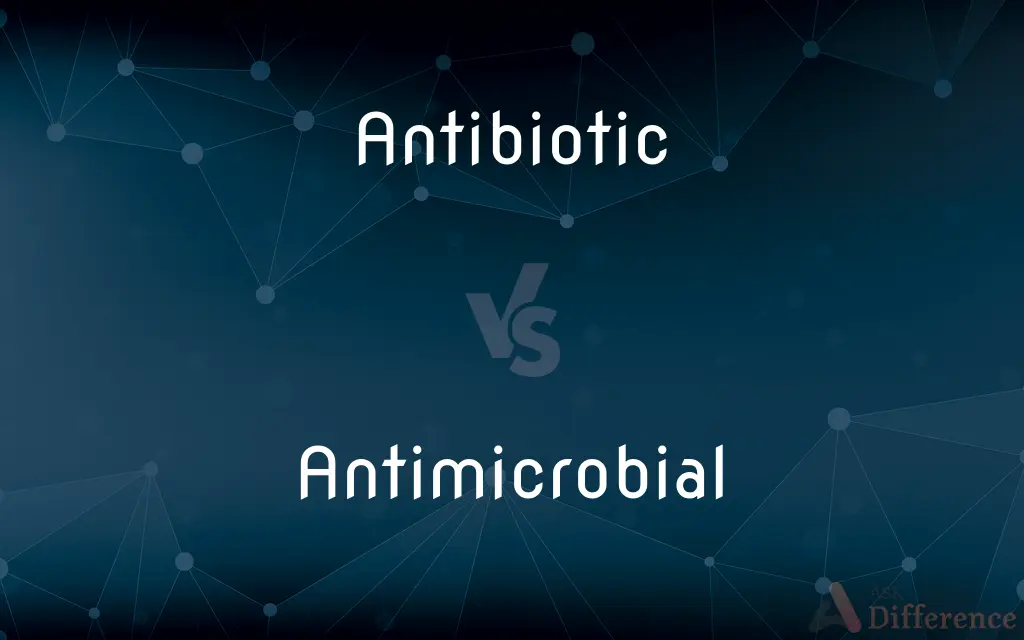Antibiotic vs. Antimicrobial — What's the Difference?
By Tayyaba Rehman & Maham Liaqat — Updated on March 13, 2024
Antibiotics target bacteria specifically, while antimicrobials act against a broad spectrum of microorganisms.

Difference Between Antibiotic and Antimicrobial
Table of Contents
ADVERTISEMENT
Key Differences
Antibiotics are a type of antimicrobial designed specifically to combat bacterial infections in humans, animals, and plants. Antimicrobials, on the other hand, encompass a broader category of agents that can act against various types of microorganisms, including bacteria, viruses, fungi, and parasites.
While antibiotics are primarily used to treat bacterial infections, antimicrobials can be found in products ranging from hand sanitizers and household cleaners to medications designed to treat fungal infections or parasitic infestations. This reflects the broader scope of antimicrobials in targeting different types of microorganisms.
The development and use of antibiotics have revolutionized medicine by providing effective treatment for previously life-threatening bacterial infections. However, the misuse and overuse of antibiotics have led to the emergence of antibiotic-resistant bacteria, posing significant challenges to public health.
Antimicrobials, due to their broad-spectrum activity, are used in a variety of settings, including healthcare, agriculture, and consumer products. The widespread use of antimicrobials has also raised concerns about the development of resistance, not only in bacteria but in other microorganisms as well, necessitating judicious use across all applications.
Comparison Chart
Target
Bacteria
Various microorganisms (bacteria, viruses, fungi, parasites)
ADVERTISEMENT
Use
Treating bacterial infections
Treating a wide range of infections, disinfection
Examples
Penicillin, amoxicillin
Antibiotics, antifungals, antivirals, antiparasitics
Scope
Narrower, focused on bacteria
Broader, against multiple microorganisms
Concerns
Antibiotic resistance
Resistance across various microorganisms
Compare with Definitions
Antibiotic
Used in medicine, veterinary, and agriculture.
Antibiotics are given to livestock to prevent disease and promote growth.
Antimicrobial
Acts against a broad spectrum of microorganisms.
Antimicrobial hand sanitizers can kill a variety of germs, including bacteria and viruses.
Antibiotic
Works by inhibiting bacterial growth.
Tetracycline inhibits protein synthesis in bacteria, stopping their growth.
Antimicrobial
Used in healthcare, consumer products, and agriculture.
Antimicrobial coatings are applied to medical devices to prevent infections.
Antibiotic
Designed to combat bacterial infections.
Penicillin is used to treat bacterial infections like strep throat.
Antimicrobial
Found in disinfectants, antiseptics, and medications.
Antifungal creams for athlete's foot are a type of antimicrobial medication.
Antibiotic
Specific to bacteria, not effective against viruses or fungi.
Antibiotics are not effective against the common cold or flu, which are caused by viruses.
Antimicrobial
Includes antibiotics as a subset.
All antibiotics are antimicrobials, but not all antimicrobials are antibiotics.
Antibiotic
Can lead to antibiotic resistance if overused.
Overprescribing antibiotics can lead to resistant bacterial strains.
Antimicrobial
Can contribute to resistance across multiple microorganisms.
Widespread use of antimicrobial products can lead to resistance in bacteria and fungi.
Antibiotic
An antibiotic is a type of antimicrobial substance active against bacteria. It is the most important type of antibacterial agent for fighting bacterial infections, and antibiotic medications are widely used in the treatment and prevention of such infections.
Antimicrobial
Capable of destroying or inhibiting the growth of microorganisms
Antimicrobial hand sanitizers.
Antibiotic
A substance, such as penicillin or erythromycin, produced by or derived from certain microorganisms, including fungi and bacteria, that can destroy or inhibit the growth of other microorganisms, especially bacteria. Antibiotics are widely used in the prevention and treatment of infectious diseases.
Antimicrobial
An antimicrobial drug.
Antibiotic
Of or relating to antibiotics.
Antimicrobial
(pharmaceutical effect) tending to destroy or capable of destroying microbes
Antibiotic
Of or relating to antibiosis.
Antimicrobial
(pharmaceutical effect) inhibiting the growth of microbes
Antibiotic
Destroying life or preventing the inception or continuance of life.
Antimicrobial
(pharmaceutical effect) preventing or counteracting the pathogenic action of microbes
Antibiotic
(pharmaceutical drug) Any substance that can destroy or inhibit the growth of bacteria and similar microorganisms, generally transported by the lymphatic system.
Antimicrobial
An agent that destroys microbes, inhibits their growth, or prevents or counteracts their pathogenic action
Antibiotic
(pharmaceutical effect) Of or relating to antibiotics.
Antimicrobial
An agent (as heat or radiation or a chemical) that destroys microorganisms that might carry disease
Antibiotic
(obsolete) Of or relating to the theory that extraterrestrial life does not exist.
Antimicrobial
Capable of destroying or inhibiting the growth of disease-causing microorganisms
Antibiotic
Any chemical substance having therapeutically useful antibacterial or antifungal activity; - used commonly but loosely for synthetic as well as natural antimicrobial agents.
Antibiotic
Of or pertaining to an antibiotic.
Antibiotic
Of or relating to antibiotic drugs
Common Curiosities
Can antibiotics treat viral infections?
No, antibiotics are designed to treat bacterial infections and are not effective against viruses.
Are all antibiotics antimicrobials?
Yes, all antibiotics are a subset of antimicrobials, but not all antimicrobials are antibiotics.
Can the use of antimicrobial products lead to resistance?
Yes, the widespread and improper use of antimicrobial products can contribute to resistance in various microorganisms, not just bacteria.
Can antimicrobial resistance affect human health?
Yes, antimicrobial resistance can lead to infections that are harder to treat, increasing the risk of disease spread, severe illness, and death.
Can antimicrobials be used in non-medical settings?
Yes, antimicrobials are used in a variety of settings, including healthcare, agriculture, and consumer products like disinfectants and antiseptics.
What are some examples of antimicrobial agents?
Examples include antibiotics for bacteria, antivirals for viruses, antifungals for fungi, and antiparasitics for parasites.
Why is it important to use antibiotics judiciously?
Judicious use of antibiotics is crucial to prevent the emergence and spread of antibiotic-resistant bacteria, ensuring these medicines remain effective for treating infections.
Is it safe to use antibiotics for viral infections like the flu?
No, antibiotics are ineffective against viral infections such as the flu and their unnecessary use can contribute to antibiotic resistance.
What is the main difference between antibiotics and antimicrobials?
Antibiotics specifically target bacteria, while antimicrobials act against a broad range of microorganisms, including bacteria, viruses, fungi, and parasites.
What contributes to antibiotic resistance?
The overuse and misuse of antibiotics contribute to the development of antibiotic-resistant bacteria.
What role do antimicrobials play in agriculture?
Antimicrobials are used in agriculture to prevent disease in plants and animals, but their use must be managed to avoid contributing to resistance.
How are new antibiotics developed?
New antibiotics are developed through extensive research and testing to find compounds that can effectively target bacteria without contributing to resistance.
What measures can be taken to prevent antibiotic resistance?
Measures include using antibiotics only when prescribed, completing the full course of treatment, and implementing infection control practices in healthcare settings.
How do antifungals differ from antibiotics?
Antifungals are designed to specifically target fungal infections, while antibiotics are used to treat bacterial infections. Both are types of antimicrobials.
Share Your Discovery

Previous Comparison
Correctly vs. Properly
Next Comparison
Buzzard vs. HawkAuthor Spotlight
Written by
Tayyaba RehmanTayyaba Rehman is a distinguished writer, currently serving as a primary contributor to askdifference.com. As a researcher in semantics and etymology, Tayyaba's passion for the complexity of languages and their distinctions has found a perfect home on the platform. Tayyaba delves into the intricacies of language, distinguishing between commonly confused words and phrases, thereby providing clarity for readers worldwide.
Co-written by
Maham Liaqat













































